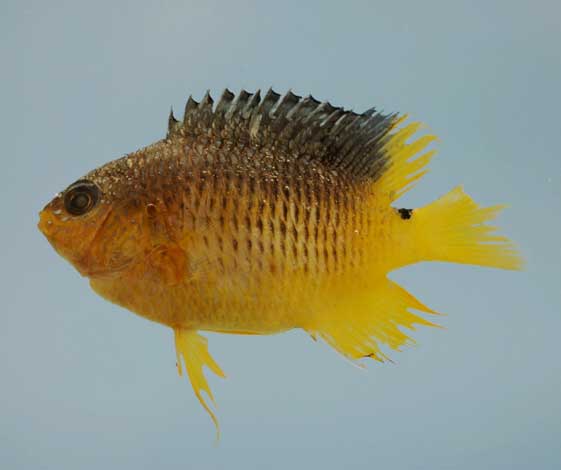
Stegastes variabilis (SEFSC Pascagoula Laboratory; Collection of Brandi Noble, NOAA/NMFS/SEFSC )
Superregnum : Eukaryota
Cladus: Unikonta
Cladus: Opisthokonta
Cladus: Holozoa
Regnum: Animalia
Subregnum: Eumetazoa
Cladus: Bilateria
Cladus: Nephrozoa
Superphylum: Deuterostomia
Phylum: Chordata
Subphylum: Vertebrata
Infraphylum: Gnathostomata
Megaclassis: Osteichthyes
Superclassis/Classis: Actinopterygii
Classis/Subclassis: Actinopteri
Subclassis/Infraclassis: Neopterygii
Infraclassis: Teleostei
Megacohors: Osteoglossocephalai
Supercohors: Clupeocephala
Cohors: Euteleosteomorpha
Subcohors: Neoteleostei
Infracohors: Eurypterygia
Sectio: Ctenosquamata
Subsectio: Acanthomorphata
Divisio/Superordo: Acanthopterygii
Subdivisio: Percomorphaceae
Series: Ovalentaria
Familia: Pomacentridae
Subfamilia: Stegastinae
Genus: Stegastes
Species: Stegastes variabilis
Name
Stegastes variabilis (Castelnau, 1855)
Syntypes: MNHN 0000-8135 (2).
Type locality: Bahia, Brazil.
References
Castelnau, F.L. 1855: Poissons. In: Animaux nouveaux or rares recueillis pendant l'expédition dans les parties centrales de l'Amérique du Sud, de Rio de Janeiro a Lima, et de Lima au Para; exécutée par ordre du gouvernement Français pendant les années 1843 a 1847. Part 7, Zoology. 2: i-xii + 1-112, Pls. 1-50.
Allen, G.R. 1991: Damselfishes of the world. Mergus Publishers, Melle, Germany. 271 pp.
Stegastes variabilis in FishBase,
Froese, R. & Pauly, D. (eds.) 2022. FishBase. World Wide Web electronic publication, www.fishbase.org, version 08/2021.
Vernacular names
English: Cocoa Damselfish
Stegastes variabilis (cocoa damselfish) is a damselfish in the family Pomacentridae, found on coral and rocky reefs in the Caribbean Sea and neighboring areas of the Atlantic Ocean and Gulf of Mexico. They are often solitary fish.[2]
Description
The cocoa damselfish is an oval, laterally compressed fish and grows to about 12.5 centimetres (4.9 in) long. The top of the head and the snout bear several blue stripes. The top half of the body is generally dark blue or brown and the bottom half is yellow. The sides are finely barred with vertical dark lines. There are two small black spots, one above the pectoral fins and the other on the top of the caudal peduncle. The large dorsal fin has 12 spines and 14 to 17 soft rays. The anal fin has two spines and 12 to 15 soft rays. The caudal fin is shallowly forked and has rounded lobes.[2]
Juveniles have a number of tiny blue spots and stripes on the head and upper part of the body, including two spots and a stripe on the upper iris. These regions also have a dusky blue sheen. A blue-rimmed black eyespot is located where the dorsal fin spines join with the soft rays. A similar blue-rimmed spot is found at the top of the caudle peduncle, and it extends down nearly as far as the lateral line. Older juveniles develop the characteristic blue and yellow coloration of the adult.[3]
Distribution
Cocoa damselfish are found in the western Atlantic by Brazil and the Caribbean.[2] The populations from Brazil and the Caribbean are genetically very distinct.[2] They are also found in Florida and the Gulf of Mexico.[4] They are marine and reef-associated. They do not migrate and have a depth range of 0 to 30 m.[2] It is common on offshore reefs, oil platforms, and wrecks. The juveniles can occasionally appear inshore.[4]
Ecology
Adults feed mainly on benthic algae but also on sponges, ascidiacea and anemones, while juveniles feed on invertebrates such as harpacticoid copepods and nemerteans.[2] Individual Stegastes variabilis don't overlap territories with other damselfish.[5] They appear to survive longer in captivity, up to 18 years, whereas they do not live beyond 12 years in the wild.[5]
Breeding
In the breeding season, the female lays eggs on the seabed where they are attached to empty shells, stones or other objects and fertilized by the male. He then guards them, aerates them and chases away intruders.[2] The males do this for seven days.[5] They are aggressive when breeding. Also there is distinct pairing during breeding.[2] Most of the communication between this species is done during breeding season.[5]
Importance to humans
They are used as commercial aquarium fish because of their size and colorfulness.[2]
Etymology
Stegastes is Greek for stegastos, which means covered.[2]
References
Bailly, Nicolas (2010). "Stegastes variabilis (Castelnau, 1855)". WoRMS. World Register of Marine Species. Retrieved 2011-12-28.
Stegastes variabilis on FishBase
Pomacentridae: Stegastes variabilis Larvae of coral reef fishes. Retrieved 2011-12-28.
Hoese, H.; Moore, Richard. Fishes of the Gulf of Mexico: Texas, Louisiana, and Adjacent Waters. p. 253.
"Stegastes variabilis (Cocoa Damselfish)" (PDF).
Retrieved from "http://en.wikipedia.org/"
All text is available under the terms of the GNU Free Documentation License

